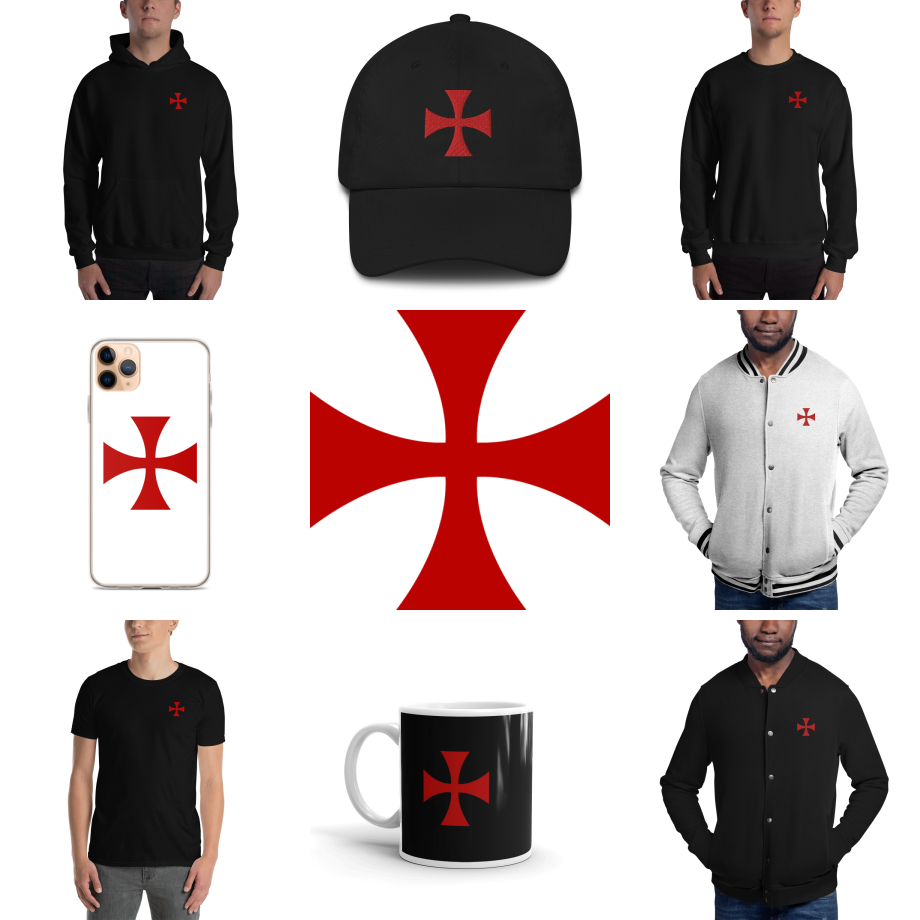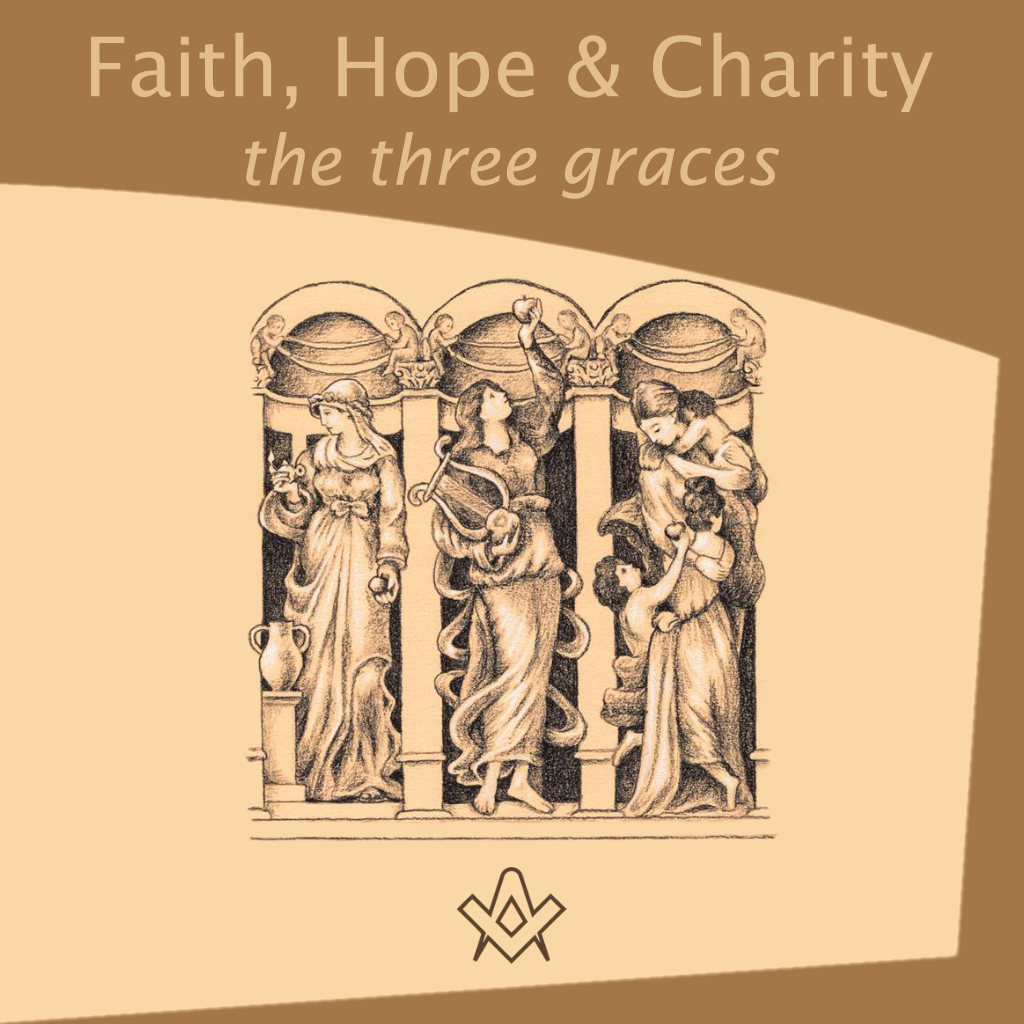
And now abideth faith, hope, charity, these three; but the greatest of these is charity
– 1 Corinthians 13:13 Authorised, or King James, Version

Exploring the origin and symbolism of Faith, Hope and Charity – the image by artist and Freemason Travis Simpkins, depicts these virtues as ‘The Three Graces’.
We tend to view the three ‘graces’ or ‘virtues’ as those in Christian theology but they are not written in theological stone, for in Freemasonry, faith, hope and charity are encountered in the very first ritual that one experiences – Initiation.
It is in the First Degree that the candidate first comes across the concepts of Faith, Hope and Charity.
He is asked to name the covering of a Freemason’s lodge; of which the correct answer is that of a Celestial Canopy of diverse colours, even the Heavens.
He is then asked how, as Masons, they can hope to figuratively enter the canopy of heaven.
He then replies that is will be by the assistance of a Ladder, which in Scripture is that of Jacob’s Ladder.
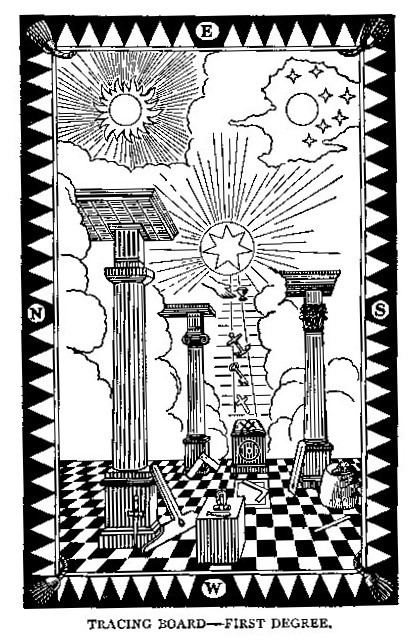
Exploring the origin and symbolism of Faith, Hope and Charity – the image by artist and Freemason Travis Simpkins, depicts these virtues as ‘The Three Graces’.
[Jacob] lay down to rest, taking the Earth for his bed, a stone for his pillow, and the Canopy of Heaven for a covering. He there in a vision saw a Ladder, the top of which reached to the Heavens, and the Angels of the Lord ascending and descending thereon.
Q -Of how many staves or rounds was this Ladder composed?
A – Of many staves or rounds, which point out as many moral virtues, but three principal ones, which are, FAITH, HOPE, and CHARITY.
Q – Why Faith, Hope, and Charity?
A – Faith in the Great Architect of the Universe; Hope in Salvation; and to be in Charity with all men.

By Tim Green from Bradford – Heart, cross & anchor
So what is this teaching for? To instil the desire to become a better man; to utilise these three Principal Moral Virtues for the greater good of mankind and one’s fellow man.
The definitions of the term ‘moral’ are all to be found deeply ingrained within the teachings of Freemasonry regardless of faith or creed: concerned with the principles of right and wrong behaviour; holding or manifesting high principles for proper conduct; a lesson that can be derived from a story or experience (Oxford English Dictionary).
Morality is the foundation of society and the cornerstone of personal development; something that the teaching of Freemasonry readily embodies and endeavours to impart to its members.
To be sure, the candidate hears and takes this advice on board but does he understand? Repeated exposure to the First Degree will no doubt reinforce this lesson but it is something that needs to be taken to heart and put into practice.
Religion or creed is no barrier to Freemasonry and even though the majority of teachings in Masonic rituals are illustrated by examples from a Christian theology, it does not take great strides to be able to translate these wise words into the language of whatever faith one has.
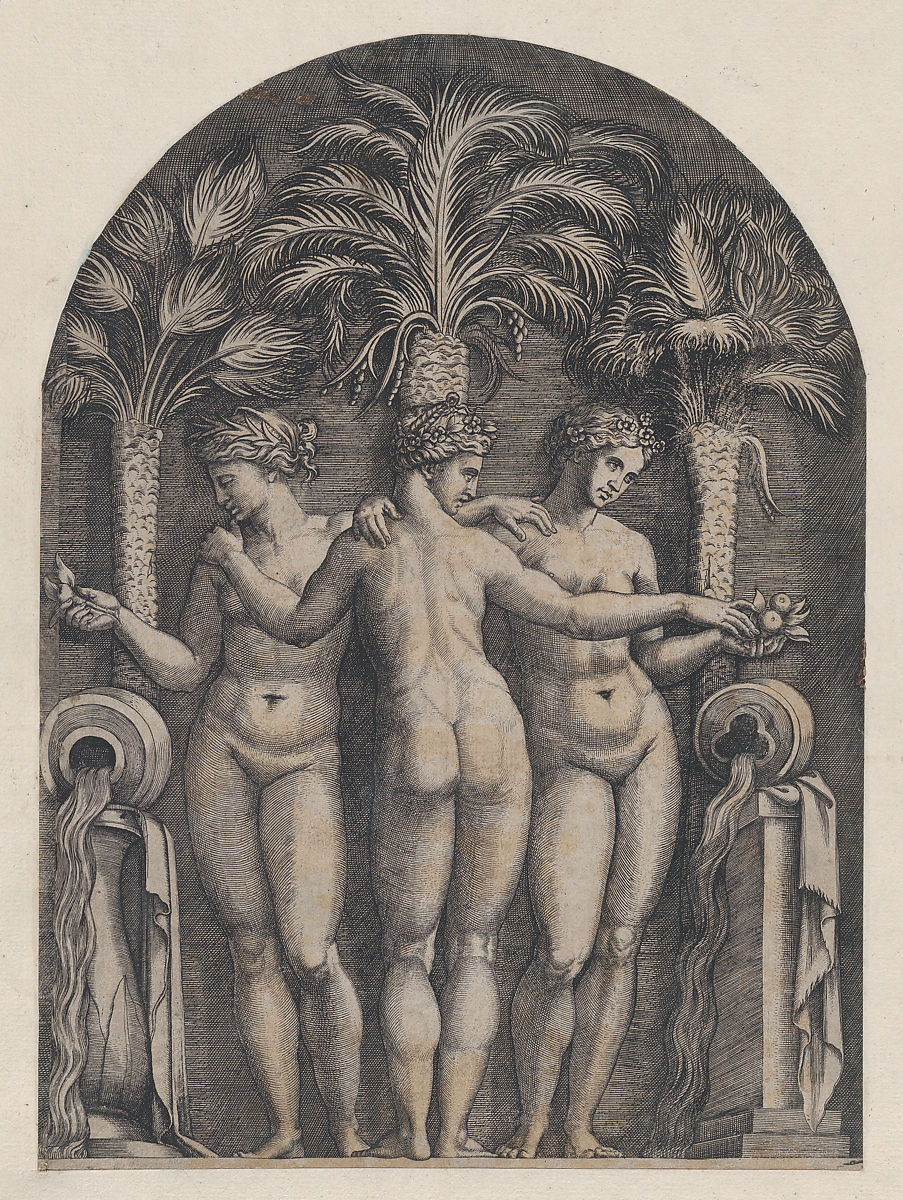
Speculum Romanae Magnificentiae: The Three Graces – ca. 1500–1534 – After Raphael, by Marcantonio Raimondi (c.1480–before 1534)
IMAGE LINKED: Metropolitan Museum, Open Access Project – PD Attribution 4.0 International (CC BY 4.0)
Why the depiction of the Charites or Graces?
In Greek mythology, the Charites (kharites) or Graces were primarily goddesses of beauty, nature, human creativity and fertility – the most prominent being Aglaea (representing Splendour), Thalia (Good Cheer), and Euphrosyne (Mirth) and they were believed to personify and bestow charm, grace, and beauty.
The Charites were usually considered the daughters of Zeus and Eurynome, but variations abound and they were also said to be daughters of Dionysus and Aphrodite or Helios and the nymph Aegle.
The Charites also held an association with the Greek underworld and the Eleusinian Mysteries. In Roman mythology they were known as the Gratiae, the ‘Graces’.
‘Grace’ can be defined in several ways, of which some are found within Masonic catechism and education:
- courteous good will
- in religious/spiritual terms – a divinely given talent or blessing; the condition or fact of being favoured by someone
- a short prayer of thanks said before or after a meal; a thanksgiving or blessing
Depictions of the graces have been found throughout the centuries.
Within Freemasonry Faith, Hope, and Charity have also been depicted as three women: the frontispiece to Albert Mackey’s Encyclopedia of Freemasonry and its Kindred Sciences; the New and Revised Edition, Vol I (Mackey, A, Hughan, W, Hawkins, L, 1927) features a stunning illustration:
Faith is shown standing between two Corinthian Pillars holding a lamp in her hand, which symbolises the ‘lamp of knowledge’
Hope stands before a window, flowers in her arms and new growth springs at her feet.
Charity, with the clouded canopy of heaven behind her, holds a small child in one arm and two older children cling to her.
This combined with the imagery and symbolism of Jacob’s Ladder offers a striking aide memoir for the Three Moral Virtues.
So how can we define and understand Faith, Hope and Charity in relationship to Freemasonry?
Naturally one thinks of the connection to the Bible and that is rightly so in some aspects due to the nature of the times in which modern Freemasonry was conceived and founded.
However, the three concepts are equally as important regardless of the religious or spiritual path the individual follows and can be put into practice in everyday life – within and without lodge.
Faith

In the First Degree the Candidate is asked ‘to define FAITH’.
The answer is that ‘it is the foundation of justice, the bond of amity, and the chief support of civil society. We live and walk by Faith. By it we have a continual acknowledgment of a Supreme Being’.
The dictionary definition(s) of ‘faith’: Complete trust or confidence in someone or something
The definition fits perfectly with one of the requirements for membership of Freemasonry – the belief (or faith) in a Supreme Being that is associated with your religious or philosophical path. The beauty of Freemasonry is the inclusion of all faiths; whether you are Christian, Jewish, Muslim, Sikh, Hindu, Shinto, Buddhist, Zoroastrian and so on.
Faith is also needed with regards to relationships and bonds with your fellow Brethren, your lodge and Freemasonry as an organisation. You feel the bond of amity and have faith that the ancient landmarks and obligations will be followed so as to create a harmonious and long-lived lodge.
Hope

‘Faith has to do with things that are not seen, and hope with things that are not in hand.’
– Thomas Aquinas
In the ritual the answer is that, Hope is an anchor of the soul, both sure and steadfast.
Hope is the belief or faith that we shall succeed; that things will turn out for the best; ‘hope’ meaning that we have a ‘feeling of expectation and desire for a particular thing to happen’ (OED)
So ‘faith’ and ‘hope’ are symbiotically intertwined – the EA is admonished to let a firm reliance on the Almighty’s faithfulness animate our endeavours but so the expectation and desire for something is not just wishful thinking, he must make efforts to fix our desires within the limits of His most blessed promises and then success will follow…if we believe a thing impossible, our despondency may render it so, but he who perseveres in a just cause will ultimately overcome all difficulties.
In religious or spiritual terms, we aspire – or hope – that we will achieve Salvation and enter the ‘Canopy of Heaven’/the hereafter/Elysium etc., at the end of our life; so we attempt to build our metaphorical ladder to the Promised Land.
In daily life, hardships, fears and frustrations are abundant; we often encounter obstacles that make life difficult; people we don’t like or those who make us feel inferior but as long as we have faith in ourselves – and our God/Supreme Being –and hope to anchor us to the right path and the way to walk it, we will succeed. Freemasonry offers the tools for all these things.
Charity
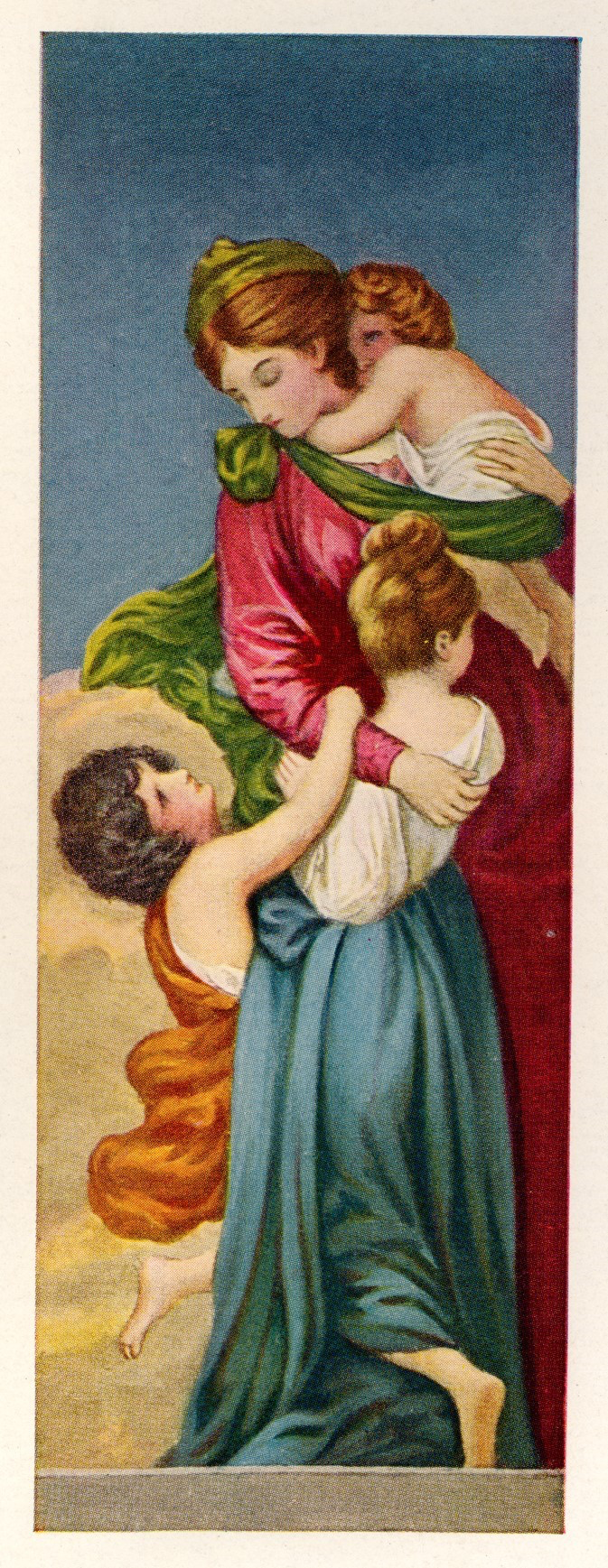
Charity, as Paul says in 1 Corinthians 13, is the greatest of all the three virtues (the interchangeable term for charity is ‘love’ in Scripture).
Though I speak with the tongues of men and of angels, and have not charity, I am become as sounding brass, or a tinkling cymbal.
And though I have the gift of prophecy, and understand all mysteries, and all knowledge; and though I have all faith, so that I could remove mountains, and have not charity, I am nothing.
And though I bestow all my goods to feed the poor, and though I give my body to be burned, and have not charity, it profiteth me nothing.
Charity never faileth: but whether there be prophecies, they shall fail; whether there be tongues, they shall cease; whether there be knowledge, it shall vanish away.
For we know in part, and we prophesy in part. But when that which is perfect is come, then that which is in part shall be done away…
And now abideth faith, hope, charity, these three; but the greatest of these is charity.
The Latin for ‘charity’ Caritas was defined by Thomas Aquinas as ‘the friendship of man for God’ and vice versa but also extends it to ‘the love of our neighbour’.
It is a reciprocal friendship and one in that the giver of charity/love sees and imitates the love of God between himself, and his fellow man.
This kind of love was known by the Greeks as agape – ‘the love of God for man and of man for God’.
Other faiths and religions have similar or related concepts:

Chesed – a Hebrew word commonly translated as ‘loving-kindness’, ‘kindness’ or ‘love’ and is central to Jewish ethics and theology.
It is a common term in the Bible for describing God’s love for mankind and God’s special relationship with the Children of Israel and is considered a virtue on its own, and also for its contribution to tikkun olam (repairing the world).
Mettā (Pali) translates variably as benevolence, loving-kindness, amity, or good will and active interest in others.
It is the first of the four virtues (Brahmavihāras) of the Theravāda school of Buddhism.

Maitrī (Sanskrit) is a term used in Jainism to reflect loving kindness to all living things.
Priti (Sanskrit) is found in Hindu traditions.
The First Degree ritual describes it as:
Lovely in itself, is the brightest ornament which can adorn our Masonic profession…Happy is the man who has, sown in his breast, the seeds of benevolence; he envies not his neighbour, he believes not a tale reported to his prejudice, he forgives the injuries of men, and endeavours to blot them from his recollection…
Catholic catechism says something very similar:
The fruits of charity are joy, peace, and mercy; charity demands beneficence and fraternal correction; it is benevolence; it fosters reciprocity and remains disinterested and generous; it is friendship and communion.
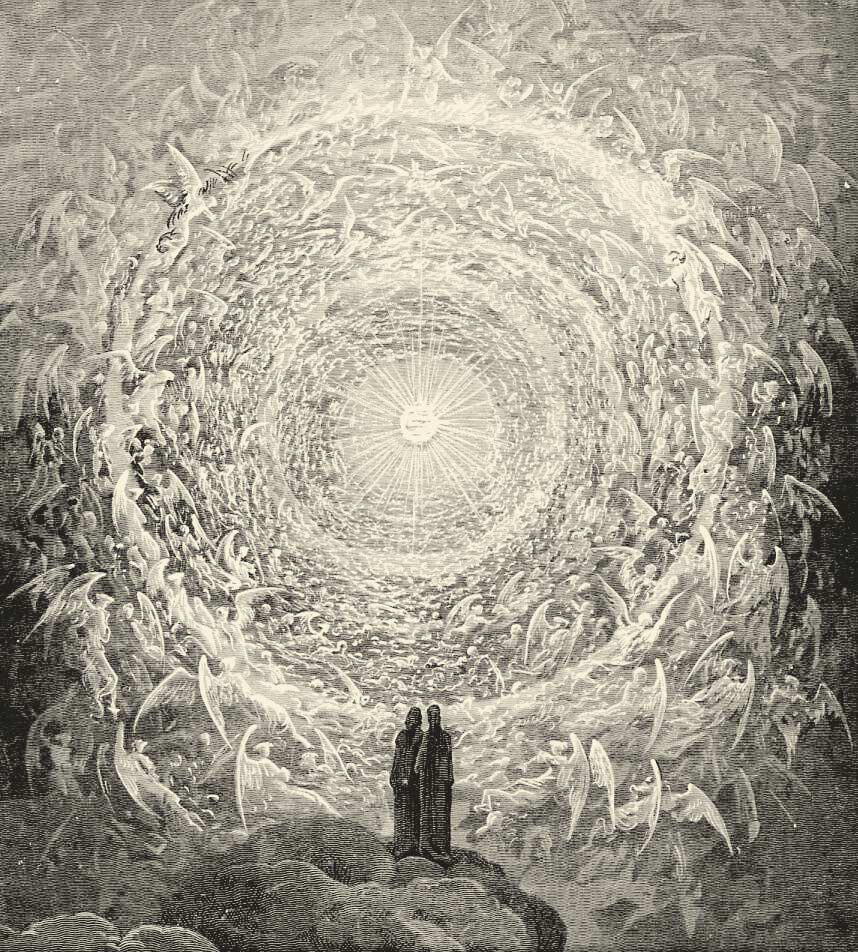
Rosa Celeste: Dante and Beatrice gaze upon the highest Heaven, The Empyrean
IMAGE LINKED: wikimedia Attribution 4.0 International (CC BY 4.0)
Charity – in practice
‘Amongst the values of Freemasonry are integrity, kindness and fairness. Caring for the community and raising money for charitable causes is important to us.’
– UGLE
Over the years, the he meaning of charity has shifted from the love of humankind, to that of the ‘voluntary giving of help, typically in the form of money, to those in need’ (OED)
All Freemasons are encouraged not only to practice charity in its cerebral or spiritual sense but also to engage in a practical one.
This is symbolically demonstrated and experienced in the First Degree and one indelibly charged lesson most Masons never forget!
One aspect of that experience is to demonstrate that you were admitted into Freemasonry in a state of poverty and to remind you to be mindful of the duty to help impoverished Brethren or others as far as you are able to but not to the detriment to yourself or close family.
Many Masons are understandably very proud of the charitable work they contribute to; charitable giving – in money or voluntarily given time and skills – is a fundamental part of the organisation.
The four historic Masonic charities – The Freemasons’ Grand Charity, the Royal Masonic Trust for Boys and Girls, Royal Masonic Benevolent Institution (RMBI) and the Masonic Samaritan Fund – have now merged to become the Masonic Charitable Foundation (MCF).
With nearly three centuries of charitable giving behind them, these former charities now have the perfect vehicle to provide help and support to Freemasons, their families and the wider community for the next three hundred years.
![]()
charity is love, not all love is charity
– Thomas Aquinas
Article by: Philippa Lee. Editor

Philippa Lee (writes as Philippa Faulks) is the author of eight books, an editor and researcher.
Philippa was initiated into the Honourable Fraternity of Ancient Freemasons (HFAF) in 2014.
Her specialism is ancient Egypt, Freemasonry, comparative religions and social history. She has several books in progress on the subject of ancient and modern Egypt. Selection of Books Online at Amazon
Recent Articles: symbolism
 Legends and Symbols in Masonic Instruction Explore the significance of Masonic legends and symbols in this insightful post. Discover how Freemasonry imparts wisdom through allegorical narratives and emblematic imagery, revealing profound moral and philosophical lessons. Unveil the deep connections between Masonic teachings and the broader quest for understanding life’s fundamental questions. |
 Discover the mystical significance of the number 33. From its mathematical marvels and artistic influence in numerology to its esteemed place in Freemasonry, delve into the history and power of this master number. Explore why 33 holds such profound meaning in various spiritual and philosophical traditions. |
 The Practice of Freemasonry - P1 Embark on a transformative journey with Freemasonry, where the exploration of your Center unlocks the Perfect Ashlar within. Through the practices of Brotherly Love, Relief, Truth, and Cardinal Virtues, discover a path of enlightenment and self-improvement. Embrace the universal creed that binds us in the pursuit of our true essence. |
 Discover the fascinating history and significance of the Warrant of Constitution within Freemasonry. Unveil the evolution of this crucial authorization, its role in legitimizing Lodges, and its lasting impact on the global brotherhood of Freemasons. Explore the intricate link it provides between tradition and modern practice. |
 Freemasonry: Unravelling the Complexity of an Influential Organization Mysterious and captivating, Freemasonry has piqued the interest of seekers and skeptics alike. With its intricate blend of politics, esotericism, science, and religion, this enigmatic organization has left an indelible mark on society. Prepare to delve into the secrets of Freemasonry and unlock its hidden depths. |
 Unlocking the Mysteries of Freemasonry: In the hallowed halls of Freemasonry, a powerful symbol lies at the heart of ancient rituals and teachings—the Volume of the Sacred Law. This sacred book not only guides the spiritual and moral journey of Freemasons but also serves as a beacon of universal wisdom and enlightenment. |
 The Ancient Liberal Arts in Freemasonry Embark on a journey of self-improvement and wisdom with Freemasonry's guiding principles. Ascend the winding stairs of moral cultivation, analytical reasoning, and philosophical understanding. Embrace arithmetic's mystical properties and geometry's universal truths. Let the harmony of the universe inspire unity and growth. Discover the profound, hidden knowledge in Freemasonry's path to enlightenment. |
 Initiation rituals around the world are filled with fascinating elements and different images. One of them is that of darkness. When societies speak of darkness, they often mean a lack of knowledge, a lack of choice, or a symbol of evil. During initiation rituals, darkness is used to represent the initiate's lack of knowledge about the world, society, and initiation in general. It can also represent the initiate's inability to make a choice or endure a situation. Whether you have participated in an initiation rite or not, the meaning of darkness remains an intriguing concept worth exploring. Initiation rituals around the world are filled with fascinating elements and different images. One of them is that of darkness. When societies speak of darkness, they often mean a lack of knowledge, a lack of choice, or a symbol of evil. During initiation rituals, darkness is used to represent the initiate's lack of knowledge about the world, society, and initiation in general. It can also represent the initiate's inability to make a choice or endure a situation. Whether you have participated in an initiation rite or not, the meaning of darkness remains an intriguing concept worth exploring. |
 Masonic Deacon rods potentially trace their origins to Greek antiquity, symbolically linked to Hermes' caduceus. As Hermes bridged gods and mortals with messages, so do Masonic Deacons within the lodge, reinforcing their roles through ancient emblems. This connection underscores a profound narrative, weaving the fabric of Masonic rites with the threads of mythological heritage, suggesting the rods are not mere tools but bearers of deeper, sacred meanings that resonate with the guardianship and communicative essence of their divine counterpart, Hermes, reflecting a timeless lineage from myth to Masonic tradition. |
 The biblical pillars erected by Solomon at the Temple's porch, hold a profound place in history. These brass behemoths are not mere decorations; they are symbols of strength, establishment, and divine guidance. Explore their fascinating construction, dimensions, and the deep meanings they carry in both biblical and Masonic contexts. |
 Unlocking the Mind's Potential: Dive deep into ground breaking research revealing how simple daily habits can supercharge cognitive abilities. Discover the untapped power within and redefine your limits. Join us on this enlightening journey and transform your world! |
 Dive deep into the symbolic importance of the trowel in Masonry, representing unity and brotherly love. From its historical roots in operative masonry to its significance in speculative masonry, this article explores the trowel's multifaceted role. Discover its connection to the sword, the story of Nehemiah, and the Society of the Trowel in Renaissance Florence. Unravel the layers of meaning behind this enduring Masonic symbol. |
 Symbolism of The Builder's Jewel Batty Langley's "The Builder’s Jewel" (1741) is a visual masterpiece of Masonic symbolism, showcasing Langley's deep understanding of Freemasonry. The frontispiece highlights key symbols like the three pillars and the legend of Hiram Abiff, emphasizing Langley's dedication to Masonic traditions and teachings. |
 Unveil the mystique of the colour blue in Masonic symbolism. A hue evoking universal friendship and benevolence, its roots span ancient cultures, infusing Freemasonry's core values. This article explores blue's profound significance, guiding Freemasons towards wisdom and spiritual enlightenment. Discover the fascinating journey of this universal symbol. |
 Discover the intriguing world of the plumb in Masonic symbolism with our in-depth analysis. Uncover its rich history, moral teachings, and significance in Freemasonry, guiding members on their path to truth, integrity, and justice. Immerse yourself in the captivating power of this symbol that shapes lives within the brotherhood. |
 Unlock the mysteries of Freemasonry with 'The Key,' a profound Masonic symbol. This seemingly simple instrument holds a deeper meaning, teaching virtues of silence and integrity. Explore its ancient roots, from Sophocles to the mysteries of Isis, and discover how it symbolizes the opening of the heart for judgment. |
 Unlock the secrets of the Freemasonry with The Blazing Star - a symbol that holds immense significance in their rituals and practices. Delve into its history, meaning and role in the different degrees of Freemasonry with expert insights from the Encyclopedia of Freemasonry by Albert Mackey. Discover the mystique of The Blazing Star today! |
 There is no symbol more significant in its meaning, more versatile in its application, or more pervasive throughout the entire Freemasonry system than the triangle. Therefore, an examination of it cannot fail to be interesting to a Masonic student. Extract from Encyclopedia of Freemasonry by Albert Mackey |
 The Hiramic Legend and the Myth of Osiris Hiram Abiff, the chief architect of Solomon’s Temple, is a figure of great importance to Craft Freemasonry, as its legend serves as the foundation of the Third Degree or that of a Master Mason. He is the central figure of an allegory that has the role of teaching the Initiate valuable alchemical lessons. Although his legend is anchored in biblical times, it may have much older roots. |
 This rite of investiture, or the placing upon the aspirant some garment, as an indication of his appropriate preparation for the ceremonies in which he was about to engage, prevailed in all the ancient initiations. Extract from The Symbolism of Freemasonry by Albert G. Mackey |
 The All-Seeing Eye of God, also known as the Eye of Providence, is a representation of the divine providence in which the eye of God watches over humanity. It frequently portrays an eye that is enclosed in a triangle and surrounded by rays of light or splendour. |
 What's in a Word, Sign or Token? Why do Freemasons use passwords, signs, and tokens? As Freemasons we know and understand the passwords, signs and tokens (including grips), which are all used a mode of recognition between members of the fraternity. |
 A Temple of Living Stones: Examining the Concept of a Chain of Union What are the origins of the Chain of Union? And how did they come about ? The answers may surprise some members as W Brother Andrew Hammer investigates, author of Observing the Craft: The Pursuit of Excellence in Masonic Labour and Observance. |
 One of the best loved stories for the festive season is ‘A Christmas Carol’. A traditional ghost story for retelling around the fire on a cold Christmas Eve, it is a timeless classic beloved by those from all walks of life. Philippa explores the masonic allegory connections… |
 The Trowel - Working Tool of the Master Mason The Trowel is the symbol of that which has power to bind men together – the cement is brotherhood and fellowship. |
 Two Perpendicular Parallel Lines The point within a circle embordered by two perpendicular parallel lines, with the Holy Bible resting on the circle, is one of the most recognizable symbols in Freemasonry. It is also one which always raises a question. How can two lines be both perpendicular and parallel? |
 "The first great duty, not only of every lodge, but of every Mason, is to see that the landmarks of the Order shall never be impaired." — Albert Mackey (1856) |
 It is common knowledge that the ancient wages of a Fellowcraft Mason consisted of corn, wine, and oil. |
 “Do not come any closer,” God said. “Take off your sandals, for the place where you are standing is holy ground.” Exodus 3:5 |
 The Secret Language of the Stone Masons We know of Masons' Marks but lesser known are the 'argots' used by the artisans - in part 2 of a series on the social history of the Operative Masons we learn how the use of secret languages added to the mystery of the Guilds. |
 The phrase appears in the Regius Poem. It is customary in contemporary English to end prayers with a hearty “Amen,” a word meaning “So be it.” It is a Latin word derived from the Hebrew word - Short Talk Bulletin - Vol. V June, 1927, No.6 |
 Egypt's 'Place of Truth' - The First Operative Stone Masons' Guild? Was ancient Egypt's 'village of the artisans' the first operative stone masons' guild? And was their use of 'identity marks' a forerunner of the Mason's Marks of the cathedral builders of the Middle Ages? Read on for some possible answers… |
 The Pieces of Architecture and the Origin of Masonic Study Discover the journey of the Apprentice – from Operative to Speculative. This journey has been carried out since the times of operative Freemasonry but today the initiate works in the construction of his inner temple. |
 The Builders' Rites - laying the foundations operatively and speculatively The cornerstone (also ‘foundation’ or ‘setting’ stone) is the first stone to be set in the construction of the foundations of a building; every other stone is set in reference to this. |
 Applying the working tools to achieve our peculiar system of morality. |
 We take an in-depth look at the 47th Proposition of the 1st Book of Euclid as part of the jewel of the Past Master. |
 The Cable Tow: Its Origins, Symbolism, & Significance for Freemasons - Unbinding the significance of the cable tow. |
 We examine at one of the most impressive moments of the initiatory ceremony, a certain rite known as Circumambulation, and ask what is its meaning and purpose ? |
 So, what is the Level? And why do we use it in Freemasonry? |
 What is the mysterious pigpen or Masonic cipher that has been used for centuries to hide secrets and rituals? |
 The Story of the Royal Arch - The Mark Degree Extracted from William Harvey's 'The Story of the Royal Arch' - Part 1 describes the Mark Degree, including the Working Tools. |
 Ashlars - Rough, Smooth - Story of a Stone How we can apply the rough and smooth Ashlars with-in a masonic context |
 A detailed look at the Chamber of Reflection: A Revitalized and Misunderstood Masonic Practice. |
 Exploring the origin and symbolism of Faith, Hope and Charity |
 The Noachite Legend and the Craft What is it to be a true Noachidae, and what is the Noachite Legend and the Craft ? |
 In Masonic rituals, Jacob’s ladder is understood as a stairway, a passage from this world to the Heavens. |
 What is the meaning of the Acacia and where did it originate ? |
 What is the connection with the Feasts of St John and Freemasonry |
 The Forget-Me-Not and the Poppy - two symbols to remind us to 'never forget' those who died during the two World Wars. |
 Biblical history surrounding the two pillars that stood at the entrance to King Solomon's Temple |
 Is there a direct link between Judaism and Freemasonry? |
 The symbolism of the beehive in Masonry and its association with omphalos stones and the sacred feminine. |
 The Wages of an Entered Apprentice |
 An explanation of the North East corner charge which explores beyond one meaning Charity - |
 A brief look at the origins of the two headed eagle, probably the most ornamental and most ostentatious feature of the Supreme Council 33rd Degree Ancient and Accepted (Scottish ) Rite |
 A Muslim is reminded of his universal duties just as a Freemason. A Masonic Interpretation of the Quran's First Two Chapters |
 The three Latin words -{Listen, Observe, Be Silent}. A good moto for the wise freemason |
masonic knowledge
to be a better citizen of the world
share the square with two brothers

click image to open email app on mobile device
